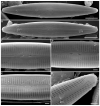Gandhia gen. nov.-A New Diatom Genus with Unusual Morphology Split Off from the Genus Navicula Bory
- PMID: 38068578
- PMCID: PMC10708461
- DOI: 10.3390/plants12233941
Gandhia gen. nov.-A New Diatom Genus with Unusual Morphology Split Off from the Genus Navicula Bory
Abstract
A new naviculoid diatom genus, Gandhia gen. nov., was described based on a detailed morphological investigation using light and scanning electron microscopy. Gandhia obtecta (Jüttner and Cox) Kulikovskiy, Glushchenko, Iurmanov, M.Thacker, B.Karthick and Kociolek comb. nov. was previously described as a member of the genus Navicula Bory sensu lato. This species differs from other species in the genus Navicula s.l. by the presence of an internal siliceous lamina covering the alveoli and forming the image of longitudinal lines on either side of the axial area, visible in LM. The presence of this siliceous lamina is similar to laminae in genera such as Pinnularia and Gomphoneis. This unusual morphology is not typical for Navicula sensu stricto, as previously noted by other scientists. Additional investigation of Gandhia obtecta comb. nov. and Gandhia ramosissimoides (H.P. Gandhi) Kulikovskiy, Glushchenko, M.Thacker, B.Karthick and Kociolek comb. nov. from waterbodies of the Western Ghats and the Himalayan region was conducted. Comparison with other species with the same morphological features included two additional species in the genus, namely, Gandhia jakovljevicii (Hustedt) Kulikovskiy, Glushchenko, M.Thacker, B.Karthick, and Kociolek comb. nov. and Gandhia lucida (Pantocsek) Kulikovskiy, Glushchenko, M.Thacker, B.Karthick and Kociolek comb. nov. We discuss the biogeographic patterns of the species, including disjuncts between Europe and Asia.
Keywords: Gandhia; India; Navicula; diatoms; morphology; new genus.
Conflict of interest statement
The authors declare no conflict of interest. The funders had no role in the design of the study; in the collection, analyses, or interpretation of data; in the writing of the manuscript, or in the decision to publish the results.
Figures




References
-
- Kociolek J.P., Blanco S., Coste M., Ector L., Liu Y., Karthick B., Kulikovskiy M., Lundholm N., Ludwig T., Potapova M., et al. DiatomBase. [(accessed on 29 July 2023)]. Available online: https://www.diatombase.org.
-
- Kulikovskiy M.S., Glushchenko A.M., Genkal S.I., Kuznetsova I.V. Identification Book of Diatoms from Russia. Filigran; Yaroslavl, Russia: 2016. p. 80. (In Russian)
-
- Kociolek J.P., Stoermer E.F. On the taxonomy and ultrastructure of the fossil diatom Gomphoneis cantalica (Brun & Hérib.) M. Schm. Cryptogam. Algol. 1986;7:1–8.
-
- Kulikovskiy M., Gusev E., Andreeva S., Annenkova N. Phylogenetic position of the diatom genus Geissleria Lange-Bertalot & Metzeltin and description of two new species from Siberian mountain lakes. Phytotaxa. 2014;177:249–260. doi: 10.11646/phytotaxa.177.5.1. - DOI
-
- Round F.E., Crawford R.M., Mann D.G. The Diatoms. Biology and Morphology of the Genera. Cambridge University Press; Cambridge, UK: 1990. p. 747.
Grants and funding
LinkOut - more resources
Full Text Sources

